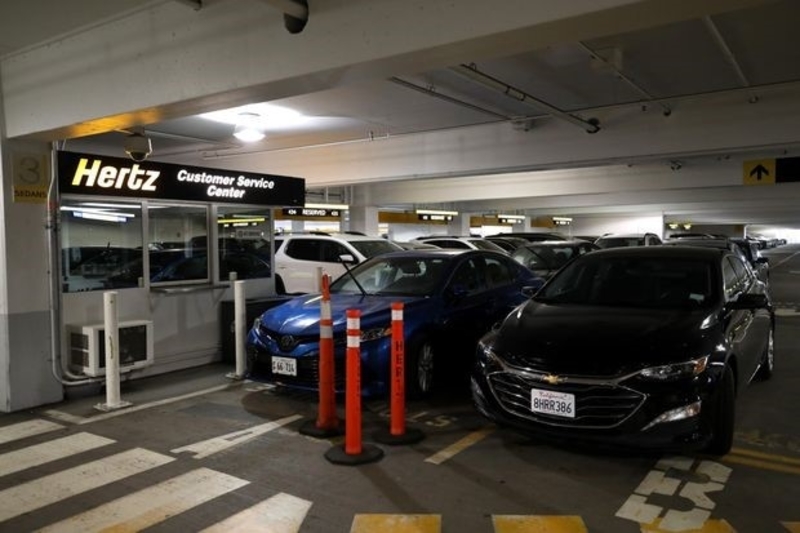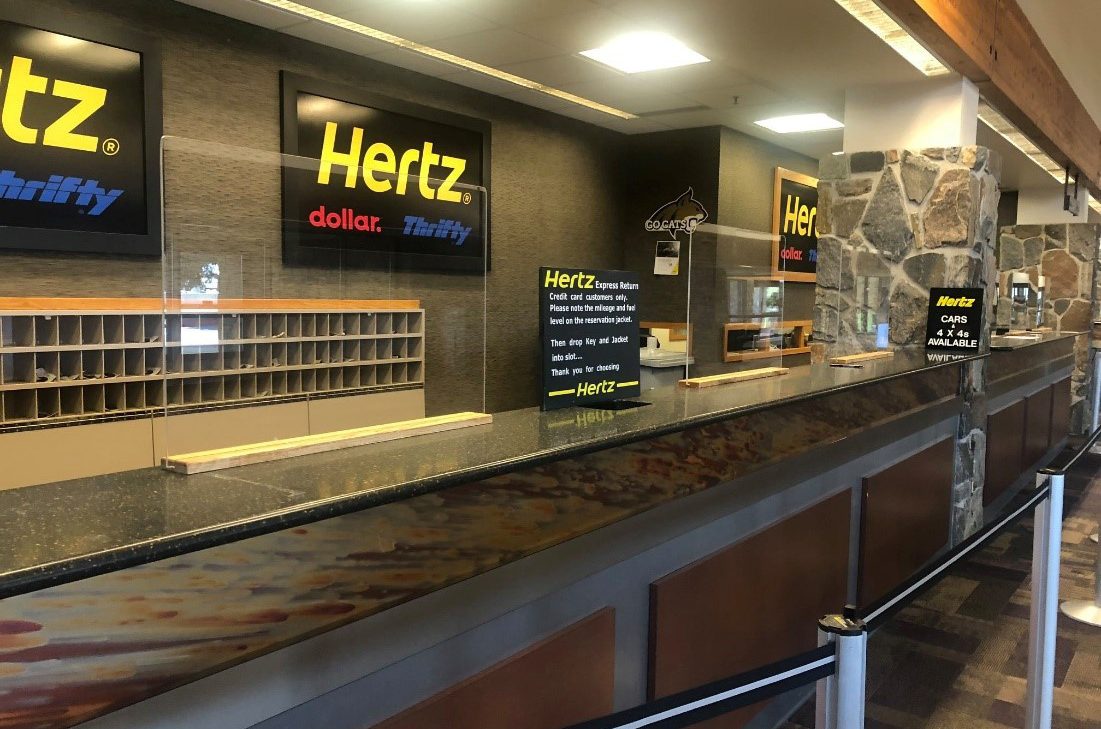Hertz’s Bankruptcy and Its Influence on the Car Industry
The Hertz Corporation, a subsidiary of Hertz Global Holdings Inc., is a billion-rental company based in Estero, Florida. While Hertz focuses on offering service to leisure travelers, its sister companies like Dollar, Thrifty cater to cost-conscious travelers.
Hertz is like an iconic brand that every time you need to rent a car, Hertz would be the most popular option. It has operated 10,200 corporate and franchise locations internationally. Hertz has become the most recognized brand in the world when its name appears almost everywhere from North America to Europe, Latin America or Asia, etc.
Also, this corporation has had a huge impact on the car industry. It used to be the most valuable customer to General Motors or Nissan Motors to sell large numbers of cars at once.
Yet after 100 years in business, this corporation filed on bankruptcy on May 22. The reason for their bankruptcy is considered due to the pandemic, which has ruined the traveling industry and indirectly affected Hertz. However, Hertz’s problems have started long before the pandemic. They could be because of ineffective leadership or unnecessary acquisitions. But before jumping to the reasons for their failure and its consequences, let us look at their history.
The Story of Hertz
The story of this iconic brand dated back to the year 1918. Thus, this corporation was aged more than 100 years old. Surprisingly, the company was originally known as a Rent-A-Car Inc, which was founded by Water L. Jacobs. This guy also started his venture with a dozen Model T Fords. Within 5 years, his company owned a fleet of 600 vehicles and earned a revenue of $1 million. This was a huge success in 1923.
John Hertz, an owner of a truck and coach company, paid attention to this young company. He decided to purchase Rent-A-Car and renamed it to Hertz Drive-Ur-Self System. Although he purchased the whole company, he still let Jacobs keep his position as the president. Jacobs even remained in the same position after General Motors became interested in a successful venture and purchased it in 1926.
General Motors planned to expand aggressively to the areas including airports such as Chicago Midway. They also started opening in Canada, and after World War II, France was the next target for their expansion.
In 1953, John Hertz, the former founder repurchased the brand through another of his successful companies and created Hertz corporation. Later, he purchased a truck leasing company which owned 4,000 trucks. Hence, by 1954, Hertz corporation had an impressive number of vehicles which were 15,500 trucks and 12,900 cars.
The ownership in Hertz became more complicated since Hertz sold the corporation again for Radio Corporation of America in 1967. Although this corporation could hold on to Hertz for almost 20 years, Hertz was again sold to another corporation, UAL corporation, a former name of United Airlines Holdings, for $590 million. Two years later, Hertz corporation continued to change its owner. Park Ridge, which was owned and operated by Ford Motor Company, purchased Hertz with a price of $1.3 billion.
Hertz worked well for Ford. In a few years, this rental business contributed up to 10% of Ford’s pre-tax profits. It appeared that under Ford’s ownership, Hertz could grow even higher. In 2002, Hertz became the first international rental company to expand in China, which is a very lucrative market. Although it had been profitable for some years, Ford considered Hertz as a headache since they were facing tough times of their own. Hence, once again, it got a new owner. In 2005, a private equity group including big names like Merrill Lynch purchased Hertz with a price of $5.6 billion, which was not a small amount of money. It was under this new ownership that in 2012, Hertz had a big acquisition of Dollar-Thrifty for $2.3 billion, which gave Hertz 10,400 locations and presence in 150 countries in total.
Several investors used to take part in Hertz because it is an iconic brand and used to perform well. In the past, they created membership programs, on-the-spot delivery, led the industry with innovations such as Sirius XM radio in 2000, car sharing in 2007, and photographic testing to ensure the state of rentals. Moreover, they also collaborated with different brands to provide specialty cars. Some of them could be listed as Jaguar, Corvettes, modified Shelby Mustangs. Then Hertz joined in a green collection, which proved it to be the most fuel-efficient in the industry. This has made Hertz stand out among its rivals and grow higher. By 2014, Hertz owned over half-a-million cars in the U.S. alone including specialty cars, hybrids, and luxury vehicles.
The Reasons for Hertz’s Failure
A fragile business

Hertz was considered as an expensive and fragile business. On average, hertz bears a loss of $170 million per year in damages to its rentals. Furthermore, cars are the assets that will depreciate overtimes, which explains that Hertz had to pay a lot in maintenance as well as the vehicle’s depreciation.
Like other rental businesses, Hertz used their own fleet to leverage credit in order to maintain it. With the profit coming from the operation, it tried to pay off the debts, yet the company struggled in coming up with payments in recent years. The reason could be the intense competition from Uber or Lyft.
The coronavirus pandemic
Hertz not only had to contend with tough competition in the car-rental space, but it was also heavily affected by the COVID in 2020. This caused the business to file for bankruptcy protection with $19 billion in debt and nearly 700,000 vehicles that have been largely idled.
It is true that the decline in travel due to the pandemic has made the entire rental car industry struggle this year. Rentals at airport locations and air travel contribute to approximately two-thirds of its revenue and these activities have fallen sharply since the coronavirus hit. The number of people who passed through TSA checkpoints at US airports has dropped 94% compared with a year ago.
Although Hertz filed for bankruptcy, it does not mean that the company is forced out of business. Several companies used to go through this process and gain profits again, such as automaker General Motors and many of the nation’s airlines. However, the chance for a business to staying in business after filing for bankruptcy is not high and many companies have not survived during this process.
The greedy owners
The problems of Hertz were not solely caused by the pandemic. The company has been self-inflicted long before. Let us travel back to 2005 that the private equity group purchased Hertz for $5.6 billion. When they purchased the company, they also had to take around $10 billion in debt. Thus, what they did immediately after the acquisition was to take out a $1 billion dividend. And the contradictions continued coming when the CEO Mark Frissora, who shook the company to the core. He laid off employees and cut costs all around, which made sense since this is what a business would do if facing debt. Yet later he received a $19.2 million compensation package for it, which is what a good leader would not do if his company is in deep debt.
Expensive acquisition
In 2012, Hertz decided to merge with Dollar Thrifty with the aim of buying out the competition and expanding operations. To complete the acquisition, it had to sell one of its companies, Advantage. However, four months later, Advantage went bankrupt. Then experts conducted an investigation of this sudden bankruptcy. It turned out to be the failure of all sides, including the Federal Trade Commission, which approved the deal in the first place.
Joining with Dollar Thrifty took more effort than Hertz expected. Dollar and Thrifty allowed the tires to wear out thinner than Hertz did. Thus, to make it more standardized, an investment of $30 million was made by Hertz with the mere purpose of tire replacement. This merger was expected to save Hertz $100 million, yet indeed, it costed them $70 million. By the end of 2012, Hertz had $20.2 billion in debt.
Fraud

As known, when the depreciation occurs, the car’s value goes down, which gradually reduces the company’s value. Thus, Frissora came up with a terrible idea, which was to keep the cars longer than usual so that the depreciation curve would soften in the accounting books. And the older cars would be sent back to the budget fleets like Dollar, Thrifty and Firefly.
It is understandable that hiding this from consumers and authorities was impossible. Hence, in 2014, Hertz was charged with fraud, and the guy Frissora was fired, yet he was found not guilty. Later, Hertz had to pay $16 million for the SEC to settle. They also sued Frissora and the other three managers. And Frissora sued back. It can be said that Hertz was not lucky to have those greedy managers to lead them and constantly destroy their business.
Wrong moves of the new investor
Carl Icahn, a very successful businessman, had a belief that he could turn around Hertz. Thus, in 2014, he purchased a total of 39% of the company and three seats on the board for $2.3 billion.
Later he placed John Tague, a former COO of United Airlines as CEO. While there was a better candidate for that position, the former CEO of Dollar, Scott Thompson, who had plenty of experience in this industry. And Tague was not the right CEO for Hertz. He renewed the fleet with Sedans when SUVs were more favored in the market.
In 2017, Tague left the company, and the new CEO came, Kathryn Marinello. She made some good progress when shrinking the fleet and shifting to SUVs. Thus, the company had nine quarters of earnings and growth under control of this new CEO. It seemed like the company could have a possible recovery. But 2020 came, the pandemic swiped out traveling businesses. The debt was too high, and Hertz could not manage to make payments on their leasing operations and finally filed for bankruptcy on May 22.
Weirdness after Hertz’s Declaration on Bankruptcy?
On May 26, Carl Icahn, the largest shareholder of Hertz sold his 55.3 million shares for the average price of 72 cents per share. This could help him generate $40 million of proceeds and perfect him a loss of around $1.8 billion on his Hertz investment. This is totally normal for a billionaire-largest shareholder to get what he can before the stock becomes worthless.
But the weirdness happens when after filing for bankruptcy, Hertz’s stock is still trading on the New York Exchange at a high price. During two weeks from May 26 to June 8, Hertz stock increased to $5.53 per share, which is ten times increase. This is such a non-sense and inexplicable rise while Hertz is on Chapter 11 bankruptcy.
When the uninformed investors purchase the stock of a bankrupt organization, there’s little chance that they can get their money back. Because Hertz is going bankrupt which means that it is trying to reorganize and earn some profits and pay back its debt. The smart investors will know that it is hard for creditors to get their money back. And when the creditors cannot get their money, there is no way that the shareholders can receive any cents.
These investors could be the young millennials who have little knowledge about investing. They do not know where and how to put their money. A big name like Hertz with a low-price stock might draw their attention. But this is pure gambling when they do not realize how rare it is for shareholders to get any money back in bankruptcy.
Automakers Vulnerable to Hertz’s Bankruptcy
Hertz bankruptcy not only causes the disturbance in the NY stock exchange, but it also generates numerous consequences for the car business.
It is estimated that new vehicle sales to rental cars contributed to 10%, 1.7 million vehicles last year. Hertz went bankrupt, which means it will be not going to purchase any more cars.
Sales to rental car companies are not as profitable as those to dealers for individual customers. But they are a major customer, which means that the automakers rely on them to sell large numbers of vehicles each year. For instance, GM or Nissan Motors depend on daily rental firms to “dump” cars, achieve sales records, or reduce high inventory levels. The failure of Hertz will heavily hurt the business of these automakers.
Besides, Hertz currently owns more than 500,000 vehicles in the United States. And 29% of that 500,000 vehicles are under a car manufacturer agreement program. This program ensures that 29% would not become a part of Hertz’s asset, instead, those cars would keep on belonging to the manufacturers. Thus, Hertz could avoid the risk and worry about what to do with those cars. That 29% vehicle would be probably sold by the manufacturers, who will have to face up with the loss of those surplus vehicles.

However, Hertz still had the remaining 71% of the fleet. When the company needs money to pay back the creditors, they will have to sell a large proportion of the fleet with the bottom dollar. Thus, Hertz’s bankruptcy could result in a flood of used cars and currently, the used car market is already overstocked with low demand. That supply outpaces the demand heavily affects the residual values of vehicles.
While the low price of the used cars can benefit the consumers. Yet this is slowly killing the automakers because they cannot sell their cars at the normal price. So, that flood of used cars in the market will inevitably reduce sales of the new cars. When the sales decrease, the manufacturers will have to increase the price or cut down the volume or even shut down the plant, which leads to fewer jobs in the U.S. plants.
The Bottom Lines
Hertz used to be a successful brand in the rental car industry, which knew how to apply different methods to be outstanding among the rivals. However, the pandemic hit, and they could not fight with it, which resulted in their filing for bankruptcy. Yet their failure has been due to numerous reasons and the pandemic has been a tiny part of that. Perhaps, if only Hertz had been more careful in deciding the leaders or big acquisitions, then it could have stayed and even thrived in the business.
Hertz’s bankruptcy is a shocking event for any automakers since Hertz used to be their major customer and take an important role in the car industry. That Hertz went bankrupt is also an important lesson for any investors, who had little experience in investing. Investing in a zombie-like Hertz will not guarantee that they will get any money back. Thus, the buyers and investors should be careful in choosing where to invest because nobody knows the future of a bankrupt corporation that if they can even pay back to the creditors and luckily gain some profits or get completely wiped out of business.









